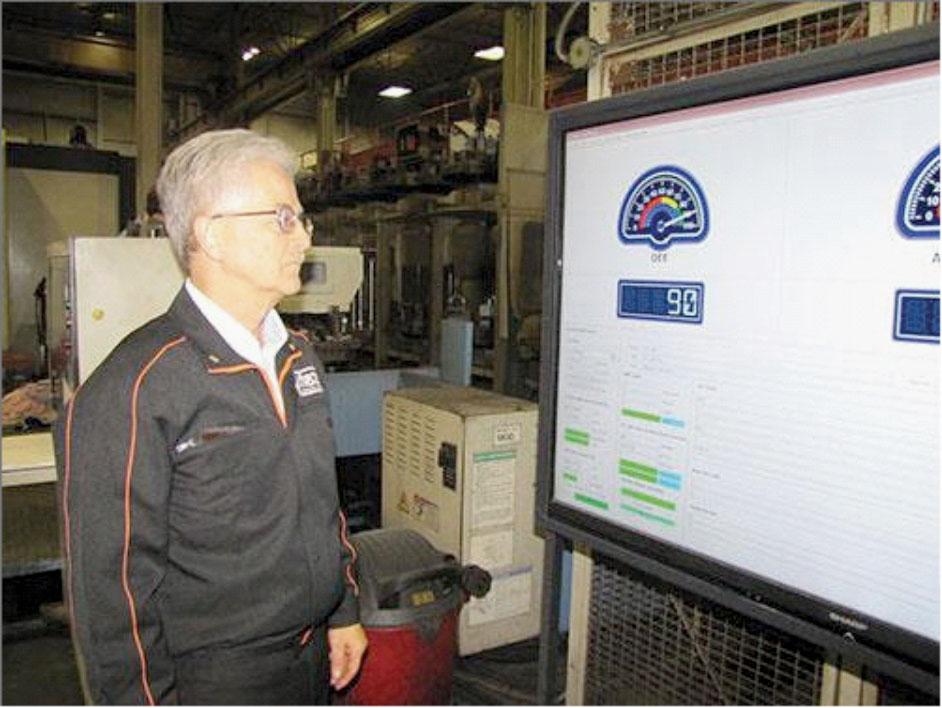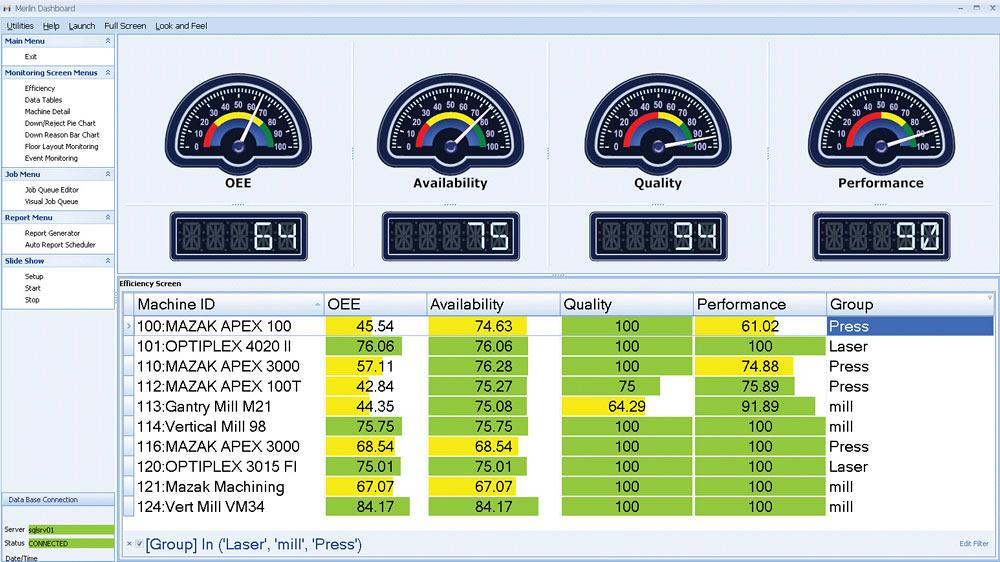- FMA
- The Fabricator
- FABTECH
- Canadian Metalworking
Entering a New Information Age for Machine Utilization
- By Marc Lobit
- July 7, 2015
- Article
- Management

Three Mazak Optiplex 3015 laser cutting systems operate in a flexible automation cell. A large monitor on the shop floor displays real-time machine performance compared to productivity targets using the Merlin system to help manage throughput. Machine metrics also can be viewed by managers throughout the manufacturing campus.
In 1973 Martin Cooper and Motorola made a demonstration call on the first brick phone. That event launched a crazy new world of connectivity that would eventually include digital information. Until then we all carried change so we could make a call from a pay phone. Since then breakthroughs that enable instantaneous communication continue to accelerate and change the world we live in.
Today there are over 10 billion mobile devices and over 3 billion mobile Internet users globally. Frankly, sometimes it’s tough to keep up. My friend’s 8-year-old daughter has a school-issued tablet that gives her immediate mobile access to the Internet. Her dad receives a digital report every Friday afternoon on the number of times she was on the classwork website and her performance in each subject. Another example is GM’s OnStar. Isn’t it interesting that many manufacturers know more about what is happening in their cars right now than the machine performance in their shops?
Until recently the tremendous availability of information has had limited impact on our fabrication world. Only large or very savvy fabricators, with strategies that incorporate Six Sigma principles and lean manufacturing, use key performance indicators (KPI) to drive their businesses. Typically, those companies have invested in processes needed to gather, transfer, and analyze machine performance and throughput data. More detailed, information based shop management is gaining traction now, even for smaller shops, and we are at the doorstep of an information age for fabrication machine utilization.
Monitoring Real-time Performance
A technology that will be integral to this evolution for fabricators is MTConnect ®, which is a platform to monitor and collect machine performance data. It is not new technology. It was developed through the cooperation of a consortium of organizations, including the Association for Manufacturing Technology, and introduced in 2008. It has already been adopted by many machine tool manufacturers.
MTConnect is an open-source, royalty- free manufacturing protocol that easily connects devices and systems from different suppliers to capture and share information in a common format, such as XML. When serving as a complete communications standard, this plug-and-play networking platform assists factories in calculating overall equipment effectiveness, monitoring all equipment from one system, reducing production losses, and identifying lean manufacturing strategies. By establishing an open and extensible channel of communication for plug-and-play interconnectivity between devices, equipment, and systems, MTConnect allows sources to exchange and understand each other’s data. Many key machine manufacturers support the protocol as a way to integrate communications between large varieties of controls, but we need to understand that it merely provides a means to transfer data similar to a USB port or Bluetooth.
Then we need to take this raw data, read and analyze it, and turn it into more actionable information using software that automatically translates the machine data into graphic reports including dashboards. This allows the current performance of cells, departments, and overall plants to be visually compared to past or target performance. These comparisons are real-time tools that can enable fabricators to manage the process rather than react to historical reporting.
The benefits of implementing these analytics include:
- Managers can see the productivity and increased profitability as it happens in real time.
- Productivity problems can be identified fast—accelerating resolution.
- Plantwide productivity typically increases by 10 to 50 percent.
- Dashboard metrics can be available for everyone on the shop floor to see.
One of the leading developers of these analytical products is Memex Automation located in Burlington, Ont. Memex developed Merlin, an industrial Internet platform for manufacturing including hardware and software machine-monitoring systems that connect directly to manufacturing equipment. Merlin is designed to monitor every machine in a shop--CNC machines, non-CNC machines, fabrication centers, and manual processes—providing information tied together in a production process manufacturing execution system.
Merlin uses various protocols (MTConnect, FANUC, Focas2, OPC, to name a few) to access relevant signals and electronic circuit boards if required, including the Universal Machine Interface board, dependent on the type of machine and controls and what is available to be monitored.

Ben Schawe, vice president of manufacturing, reviews one of the many monitors displaying machine performance located on Mazak Optonics Corp.’s production floor.
“I know that MTConnect will absolutely change fabrication, as it has for discrete manufacturing, because it is a fundamental business fact that companies want to understand how they can improve their efficiency with the equipment they have,” said David McPhail, president and CEO of Memex Automation.
Shared Information = More Productivity
A good example of the impact of implementing MTConnect and Memex software is found at Mazak Corp.’s machine tool manufacturing facility in Florence, Ky. The company employs about 750 people at the North American headquarters and manufacturing campus that covers about 800,000 sq. ft. A variety of manufacturing operations, including laser cutting, press brake bending, welding, finishing, and other fabrication processes produce turning centers, multitasking machines, and vertical machining centers, including 5-axis models.
The reasons for implementing a sophisticated machine-monitoring system were many, but a major goal was to increase the capacity of the operation to enable the shipment of 200 machine tools per month. “This total embrace of MTConnect is intended to make a statement,” said Brian Papke, president of Mazak, who personally drove the project. “We want to be a leader in both promoting and implementing MTConnect. We want our example to show the importance of moving toward data-driven manufacturing. MTConnect is an essential part of what makes data-driven manufacturing possible.”
Continuously investing in manufacturing technology allows the Kentucky iSMART Factory to be advanced and efficient, providing highquality and reliable products through its Production-On-Demand practice. “Creating a comprehensive machinemonitoring system is a big step forward, but universal connectivity and secure reporting for shop floor and plantwide communication is truly powerful,” said Ben Schawe, vice president of manufacturing.
Simply making basic dashboards visible on the shop floor increased productivity by roughly 20 percent. Machines that are stopped, waiting for materials or programs, are colorcoded red on the dashboards. When machines are obviously not running, operators feel more urgency to get them back to making parts.
Forty-two Percent Improvement
Machine monitoring delivers instantaneous, automatic, and timed proactive e-mail and text alerts to minimize downtime. Detailed analyses of downtime root causes point to areas requiring more operator training. Identification and removal of unnecessary optional stops helps recover lost production time.
Benefits of implementing MTConnect and Merlin at Mazak included a 42 percent improvement in machine utilization, a reduction of 100 hours in operator overtime per month, and a 400-hourper- month decrease in previously outsourced work, all in the first five months.
As fabricators, we are a little late to the table, but MTConnect and machine monitoring is clearly gaining traction. It has become a common point of discussion at networking events and when reviewing machine purchase requirements.

An example of a screen page configuration that Merlin can generate displays a dashboard of overall metrics, or key performance indicators (KPIs) as compared to targets including overall equipment effectiveness (OEE). OEE is a statistical measurement (OEE = Availability x Quality x Performance) used to determine machine efficiency. Real-time measurements help the user identify problems fast, before production or quality suffers. OEE measures the actual run time, quantity of parts produced, quality metric, and the actual production rate. Metrics in green indicate good results and yellow indicates underperformance. Red is used for machines that are not operating.
The benefits for those who have implemented machine monitoring are documented and dramatic. It is no longer a matter of if fabricators will embrace MTConnect and quantify productivity, but when they will implement it.
Signals that can be monitored and displayed using MTConnect and a compatible analytical software include:
•OEE metric
•Availability metric
•Performance metric
•Event monitoring
•Quality metric
•Cycle time and count
•Part name
•Part counts
•Alarm state recording
•Interrupted cycle recording
•Downtime
•Down reason codes (automatic, operator, or modal)
•Reject counts
•Reject reason codes
•E-mail/cell phone alerts
•Feed hold/op stop
•Feed/rapid/spindle override
•Feed and speed rate
•Product standard comparison
•Idle reason tracking
•Many more signals available, stored in SQL database for analysis
subscribe now


Keep up to date with the latest news, events, and technology for all things metal from our pair of monthly magazines written specifically for Canadian manufacturers!
Start Your Free Subscription- Trending Articles
- Industry Events
ZEISS Quality Innovation Days 2024
- April 15 - 19, 2024
Tube 2024
- April 15 - 19, 2024
- Düsseldorf, Germany
CTMA Economic Uncertainty: Helping You Navigate Windsor Seminar
- April 30, 2024
- Windsor, ON Canada
MME Winnipeg
- April 30, 2024
- Winnipeg, ON Canada
CTMA Economic Uncertainty: Helping You Navigate Kitchener Seminar
- May 2, 2024
- Kitchener, ON Canada














